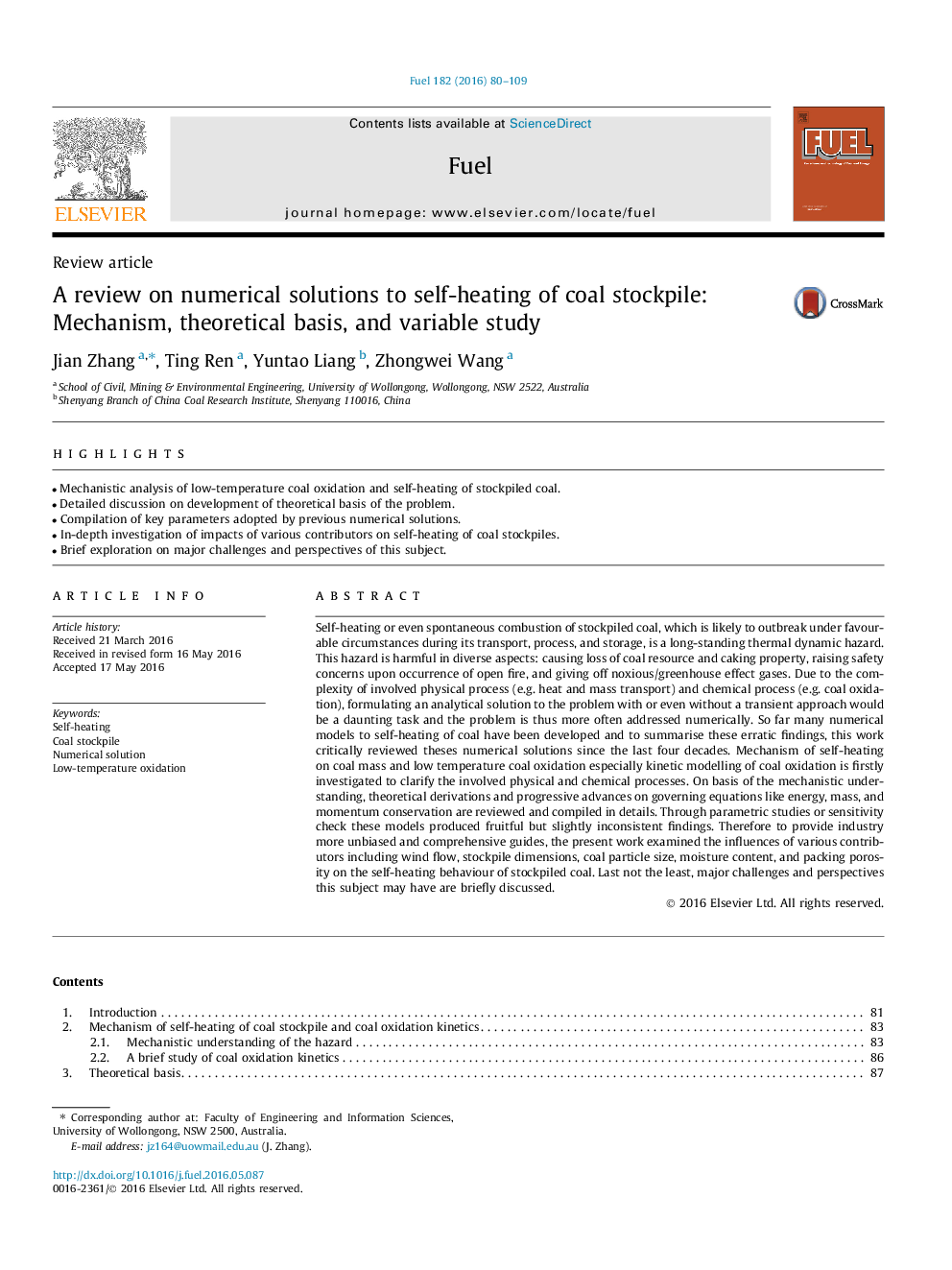| کد مقاله | کد نشریه | سال انتشار | مقاله انگلیسی | نسخه تمام متن |
|---|---|---|---|---|
| 6633378 | 461090 | 2016 | 30 صفحه PDF | دانلود رایگان |
عنوان انگلیسی مقاله ISI
A review on numerical solutions to self-heating of coal stockpile: Mechanism, theoretical basis, and variable study
ترجمه فارسی عنوان
بررسی راه حل های عددی برای خود گرمایش از ذخایر زغال سنگ: مکانیسم، مبانی نظری، و مطالعه متغیر
دانلود مقاله + سفارش ترجمه
دانلود مقاله ISI انگلیسی
رایگان برای ایرانیان
کلمات کلیدی
خود حرارت، ذخایر زغال سنگ، راه حل عددی، اکسیداسیون کم دما،
ترجمه چکیده
احتراق خودآزمایی و یا حتی احتیاج خود به خود زغال سنگ ذخیره شده، که احتمالا طی حملات، فرایندها و ذخیره سازی تحت شرایط مطلوب در حال گسترش است، خطر دینامیکی حرارتی است. این خطر در ابعاد مختلف مضر است: باعث از بین رفتن منابع زغال سنگ و نابود کردن اموال، افزایش نگرانی های امنیتی در هنگام وقوع آتش سوزی و دادن گازهای مضر / گلخانه ای می شود. با توجه به پیچیدگی فرآیند فیزیکی درگیر (مانند انتقال گرما و جرم) و فرآیند شیمیایی (به عنوان مثال اکسیداسیون ذغال سنگ)، راهحل تحلیلی برای حل مسئله با یا حتی بدون رویکرد گذرا، کار دشواری است و بنابراین مشکل بیشتر است علامت زده شده است تا کنون بسیاری از مدل های عددی برای خود گرمایش زغال سنگ توسعه داده شده است و به منظور خلاصه کردن این یافته های نامناسب، این کار انتقاد از راه حل های عددی پایان نامه از چهار دهه گذشته است. مکانیسم گرمازدگی بر روی توده زغال سنگ و اکسیداسیون زغال سنگ با درجه حرارت پایین، به ویژه مدل سازی جنبشی اکسیداسیون زغال سنگ، برای بررسی روند فیزیکی و شیمیایی در ابتدا مورد بررسی قرار گرفته است. بر اساس درک مکانیکی، مشتقات نظری و پیشرفت های مترقی در معادلات حاکم مانند حفاظت انرژی، جرم و حرکت، بررسی و جمع آوری شده در جزئیات. از طریق بررسی پارامتری یا بررسی حساسیت این مدل ها یافته های مثبت، اما کمی متناقض را به دست آورد. از این رو برای ارائه راهنمایی های بی نظیر و جامع به صنایع، کار حاضر بررسی تاثیر متقاضیان مختلف از قبیل جریان باد، ابعاد انبار، اندازه ذرات ذغال سنگ، رطوبت و تخلخل بسته بندی شده بر رفتار خود گرمایش زغال سنگ ذخیره شده است. آخرین نکته، چالش ها و دیدگاه های عمده این موضوع ممکن است به طور خلاصه مورد بحث قرار گیرد.
موضوعات مرتبط
مهندسی و علوم پایه
مهندسی شیمی
مهندسی شیمی (عمومی)
چکیده انگلیسی
Self-heating or even spontaneous combustion of stockpiled coal, which is likely to outbreak under favourable circumstances during its transport, process, and storage, is a long-standing thermal dynamic hazard. This hazard is harmful in diverse aspects: causing loss of coal resource and caking property, raising safety concerns upon occurrence of open fire, and giving off noxious/greenhouse effect gases. Due to the complexity of involved physical process (e.g. heat and mass transport) and chemical process (e.g. coal oxidation), formulating an analytical solution to the problem with or even without a transient approach would be a daunting task and the problem is thus more often addressed numerically. So far many numerical models to self-heating of coal have been developed and to summarise these erratic findings, this work critically reviewed theses numerical solutions since the last four decades. Mechanism of self-heating on coal mass and low temperature coal oxidation especially kinetic modelling of coal oxidation is firstly investigated to clarify the involved physical and chemical processes. On basis of the mechanistic understanding, theoretical derivations and progressive advances on governing equations like energy, mass, and momentum conservation are reviewed and compiled in details. Through parametric studies or sensitivity check these models produced fruitful but slightly inconsistent findings. Therefore to provide industry more unbiased and comprehensive guides, the present work examined the influences of various contributors including wind flow, stockpile dimensions, coal particle size, moisture content, and packing porosity on the self-heating behaviour of stockpiled coal. Last not the least, major challenges and perspectives this subject may have are briefly discussed.
ناشر
Database: Elsevier - ScienceDirect (ساینس دایرکت)
Journal: Fuel - Volume 182, 15 October 2016, Pages 80-109
Journal: Fuel - Volume 182, 15 October 2016, Pages 80-109
نویسندگان
Jian Zhang, Ting Ren, Yuntao Liang, Zhongwei Wang,
